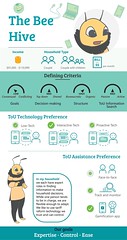
We love cheap Tuesday at the movies, understand off-peak bus ticket prices and have embraced Uber’s surge pricing. But will the nation’s consumers buy into a key proposal for Australia’s electricity tariff reform plans – increased “time-of-use” electricity pricing and the associated smart meters and smart appliances of the future?
The Household Segments for Tariff Reform study report has now been released online, following a survey of 1345 households across Australia that found that most were ready to embrace new technologies.
The energy project is managed by CitySmart – Brisbane City Council’s sustainability agency – with two consumer research studies led by Professor Rebekah Russell-Bennett and Dr Kate Letheren from the QUT Business School, with Dr Rory Mulcahy from University of Sunshine Coast (USC).
“We found the vast majority of consumers want to use digital tools to take control of their energy bills and their choice of supplier,” said Professor Russell-Bennett from QUT's School of Advertising, Marketing and Public Relations.
“The research shows that 87 per cent of households preferred to use digital tools to control responses to electricity pricing.
"Of those that want fully digital tools to manage their electricity use, there is a preference for interactive technology (36 per cent) - where households can have control - in favour of ‘set and forget’ style technology (21 per cent). This is because people value the opportunity to interact with the technology before a response occurs, such as turning off appliances.
“Understanding these digital consumers – and how best to share information with them – is a key to the success of electricity tariff reform in Australia.”
The QUT research focused on gaining the insights necessary to develop the best ways to share information and reward smarter electricity use.
“In the future, where consumers can be flexible in their use of electricity supplied by the grid, they will be rewarded with rebates or lower prices," Professor Russell-Bennett said.
“Smart meters are an essential part of this and, in the future, smart appliances may be able to communicate with smart meters, giving consumers greater control over their electricity usage.”
As part of the research Citysmart, QUT and USC created an explainer video about time-of-use pricing, which draws comparison with off-peak bus fares, Uber rides, and cheap Tuesdays for movies and pizzas.
“Previous research has found that time-of-use pricing is a pricing reform that does resonate favourably with consumers (CSIRO, 2015),” Dr Letheren said.
“We specifically looked at the consumer segments that are most likely to benefit from a digital engagement approach to tariff reform.
“We wanted to know what types of consumers would use digitally-connected tools such as track and monitors devices, augmented reality or wifi devices.”
A key outcome of the study has been the identification of six household segment types which describe how households relate with technology.
Depending on how you use technology and make decisions, your household could be a Lion Pride, Ant Colony, Flock of Geese, Domestic Cat Family, Bee Hive or Wallabies.
People interested in finding out which category their household fits into can do a seven-question online quiz.





Dr Letheren said the model of household types aimed to help decision-makers and the industry implement changes in electricity pricing in the residential sector.
“Initially technology should be targeted at the empowered segments: Lions and Wallabies,” she said.
“These groups then become the opinion leaders or ‘market mavens’ who generate positive word-of-mouth to influence the next group of consumers: those who are engaged.”
The study also identified three different levels of consumer attitude regarding engagement with technology (the “intern”, “assistant” and “manager”) – and a fourth category dubbed “the resistors”.
“Conventional education and awareness approaches in the electricity sector need to evolve to better meet the needs of today’s consumers,” said Neil Horrocks, CEO of CitySmart.
Professor Russell-Bennett said the outcomes of the project will be used to support policy development and consumer education programs for the National Energy Market.
The study was funded by Energy Consumers Australia as part of its grants process for consumer advocacy projects and research projects for the benefit of consumers.
Other funders included Energy Queensland, TasNetworks, Ausgrid, Western Power, Essential Energy and Endeavour Energy.
Media contacts:
- Mechelle McMahon, QUT media officer, media@qut.edu.au
- Rose Trapnell, QUT media team leader, 0407 585 901 or media@qut.edu.au


